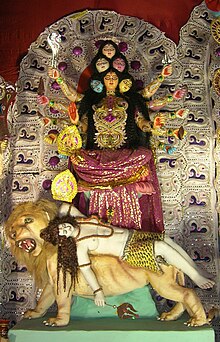DESCRIPTION OF DEVI KAMAKHYA AS PER TANTRA-S
"prabhinnāńjana sańkāśam nīlasnigdhaśiroruhām lşađavaktrām dvādaśabhujām aşțādaśavilocanām lpratyekam şațasu śīrşeşu cańdrārdhakřtaśekharām ll"
Kameshvari's complexion is like split-coryllium, Her hair is black and smooth; She has six faces, twelve arms and eighteen eyes. Each of Her six heads are adorned with crowns, each having crescent moons as crest-jewel.
"maņimāņikyamuktādi křtamālāmura: sthale lkaşțhe ca vibhratīm nityam sarvālańkāramaņđitām ll"
Her throat and breasts are adorned by gemset & pearl jewelry, and each of Her other limbs are decked with ornaments.
"pustakam siddhasūtrańca pańcavānastu tam tathā lkhařgam śaktińca śūlańca vibhratīm dakşiņē: kare: ll"
With Her six right hands Kameshvari holds a book, a sacred chord, five arrows, a sword, a spear and a trident.
"akşāmālām mahāpadmam kodaņđamcābhayam tathā lcarma paścāt piņākańca vibhratīm vāmapāņibhi: ll"
With Her six left hands, She holds a rosary, a lotus, a sugarcane, displays Abhayamudra, a chowry and Pinaka bow.
"śukla raktaņca pītańca haritam křşņameva ca lvicitram kramata: śīrşamēśāņyam pūrvameva ca lldakşiņam paścimańcēva tathēvottaraśīrşakam lmadhyańceti mahābhāga kramātcćīrşāņi varņata: ll"
The faces of the great one, facing Zenith/Northeast, East, South, West, North and centre are serially white, red, yellow, green & black, and are incredible to behold.
"śuklam māheśvarīvaktram kāmākhyāraktamucyate ltripurāpītasańkāśā śāradā haritā tathā llkřşņam kāmeśvarīvaktram caņđāyāścitramişyate ldhammillasatşata kacam pratiśīrşam prakīrtitam ll"
White face is Maheshvari, red face is Kamakhya, yellow face is Tripura, green face is Sharada, black face is Kameshvari while Chanda is of mixed colour; each of the six celebrated faces have hair on their heads.
"sińhopari sitapretam tasmin lohitapańkajam lkāmeśvarī sthitā tatra īşatprahasitānanā ll"
On a lion's back is a white corpse (of Shiva), on which a pink lotus has been laid; atop this is seated Kameshvari of smiling contenance.
"vicitrāmśukasamvītām vyāghracarmāmbarām tathā levam kāmeśvarīm dhyāyeddharmakāmārtha siddhaye ll"
She is endowed with an ethereal halo of light and clad in tiger skin; for attainment of righteousness, desires, livelihood and spirituality, always meditate upon Kameshvari. 
HISTORY
The Devi is surrounded by Her Ashtashaktis who are Guptakama, Srikama, Vindhyavasini, Kotishvari, Vanadurga, Padadurga, Dirgheshvari and Bhuvaneshvari. Additionally, there are also 64 Yogini-s around Her, while Shiva resides in 5 forms on the famed Nilachala hills of Kamakhya. Cave temple connected to all the 10 Mahavidya-s are also present in the Kamakhya hills.From an ancient time, Kamakhya has remained as the most important center of Tantra sadhana, where the Devi Mahamaya resides as the Yoni of whole creation. The present day Kamakhya Temple was built by the Koch ruler Naranarayana (Malladev) and his brother Chilarai (Sukladhvaj), according to an inscription in the Temple. However, the Darrang Raj Vamsavali, a chronicle of the Koch royal family, records the reconstruction of only the Sikhara (dome) of the Kamakhya Temple in 1565 C.E. by the architect Meghamukdam. It states that he tried to rebuild the dome twice with the original stone blocks that had fallen down, but failed. As a result, he built it in the shape of a beehive with bricks. The King also issued copper plates endowing land and the service of different paiks (servitors) to the Kamakhya Temple. These paiks consisted of Brahmans, Daivajna (astrologers), flower suppliers, garland makers, washer-men, cleaners, carpenters, oil pressers, sweetmeat makers, leather workers, cobblers, dancers, ballad singers, weavers, goldsmiths, potters, fishermen and others. Thousands of animals were also sacrificed during the worship of the goddess.Within the temple premises, we can also find two full size representational statues of Malladeva and Sukladhvaj. According to a folk legend, the Goddess Kamakhya, assuming the form of a beautiful woman, used to dance within the closed doors of the Temple at the time of the evening prayers. The Koch king Malladeva and his brother Sukladhvaj desired to see the dancing Goddess and as suggested by the chief priest Kendu Kalai, they peeped through a hole in the wall. She, however, got offended by the intrusion and tore off the head of the priest and turned the King and his brother to stone. According to another version, the King and his future descendants were henceforth, forbidden 'to cast a look even at her very hill' the Nilachal or they would die. Even today, descendants of the Koch royal family pass by the hill under the cover of umbrellas.The Garbhagriha (sanctum sanctorum) of the Kamakhya Temple dates back to the seventh century, while the Sikhara (dome of the sanctum) is dateable to the sixteenth century. The semicircular Natyamandir (dancing hall) was constructed by the Ahom monarch Rajeswar Simha in the eighteenth century. During the reign of the Ahom king Rudra Simha Krisnaram Nyayavagis, a Sakta Brahman from Nabadwip in Bengal was installed on the Nilachal as the chief priest of the Kamakhya Temple. He came to be called the Parbatiya Gosain. One of his descendants, known as the Nati-Gosain, was instrumental in the construction of the temple of the Na-Math Kali Mandir, adjacent to the Kamakhya Temple. This temple was embellished by terracotta tiles and decorative blocks and strongly resembles the temples of Bengal. An inscription of Gaurinath Simha, fixed to the inner wall of the temple premises, bears testimony to the sacrifice of one lakh animals by the Bhitarual Phukan. Even today the main worship inside the Yonipitha happens as per the Tantric methods and not by Vedic rules.The Kamakhya Temple is a living shrine and even today hordes of pilgrims pay homage to the Goddess on the Nilachal.

